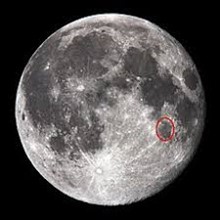The week of August 28 – September 3 takes us from Day 13 to Day 20. This week we will highlight Mare Nectaris on the moon, which is viewable Sunday night in the SE quadrant of Lunar Map at L13.
 Mare Nectaris: SE/L13; L=36°E] The Nectaris basin was excavated 3.9 billion years ago. The oldest features on the Moon formed prior to this event. Mare Nectaris is a classic example of a multi-ring basin. Tonight or tomorrow night will reveal Rupes Altai, a high cliff that is a conspicuous fragment of one of the original rings. As daylight moves across the region, try to locate hints of other ring features surrounding Mare Nectaris.
Mare Nectaris: SE/L13; L=36°E] The Nectaris basin was excavated 3.9 billion years ago. The oldest features on the Moon formed prior to this event. Mare Nectaris is a classic example of a multi-ring basin. Tonight or tomorrow night will reveal Rupes Altai, a high cliff that is a conspicuous fragment of one of the original rings. As daylight moves across the region, try to locate hints of other ring features surrounding Mare Nectaris.
THREE ITEMS OF ADDITIONAL INTEREST IN SPACE
Full Moon is on Wednesday.
On Friday, Neptune is 1.4° north of the Moon.
On Aug. 28, 1789, William Herschel discovers Enceladus, a moon of Saturn.
======================
It is highly recommended that you get a copy of Sky and Telescope’s Field Map of the Moon, the very finest Moon map available for use at the telescope. It is available for $10.95 at www.skyandtelescope.com and on Amazon. All features mentioned in this blog will be keyed to the grid on the Field Map and will look like this: Plato: [NW/D9]
Credits:
Courtesy of Gray Photography of Corpus Christi, Texas
Lunar photos: NASA / USGS / BMDO / LROC / ASU / DLR / LOLA / Moon Globe. Used by permission
- Rupes Cauchy: A Best Known Fault on the Moon - July 22, 2024
- Moon Crater Schickard – Crater Floor has Stripes - July 15, 2024
- Moon Craters Langrenus and Vandelinus - July 8, 2024